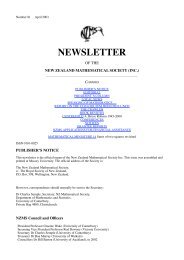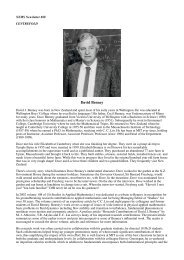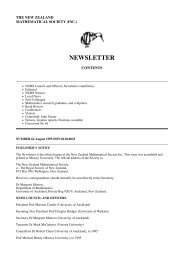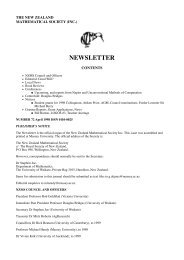newsletter - New Zealand Mathematical Society
newsletter - New Zealand Mathematical Society
newsletter - New Zealand Mathematical Society
Create successful ePaper yourself
Turn your PDF publications into a flip-book with our unique Google optimized e-Paper software.
Although it is too early to say much about the final achievements, progress was made on each problem<br />
and some downstream collaborations are being nurtured. The latter were strongly encouraged, but not<br />
required, by the MISG organisers. The Proceedings of MISG2004 are to be published by our Centre by<br />
the end of 2004 and the Equation-free Summaries will be available mid-year, both from<br />
g.c.wake@massey.ac.nz. A summary of each of the six problems is included below.<br />
Problem 1: Accurate control of strip temperature is essential for ensuring optimum product quality and<br />
throughput. <strong>New</strong> <strong>Zealand</strong> Steel has developed a simple mathematical model of their Metal Coating Line<br />
Annealing Furnace to enable prediction of strip temperature for various products and operating<br />
conditions. The model is applicable for approximately 50% of the operating time when the furnace is in<br />
equilibrium, thus is steady-state. Annealing is a process by which the steel is heated to a specific<br />
temperature in order to soften the steel by changing its structure. Considerable progress was made in<br />
developing and implementing a partial differential equation model, for the unsteady situation. The<br />
Industry representatives expressed satisfaction with the outcomes and arrangements are being made by<br />
the moderators (Mark McGuinness and Steve Taylor) for ongoing work. NZ Steel, now Bluescope Steel,<br />
also attended MISG2003 in Adelaide as problem sponsors.<br />
Problem 2: This was specifically modelling the energy exchange between the chickens and their shed<br />
environment. The chicken shed modelled has chickens placed as day old chicks at a stocking density of<br />
21.3 birds per square metre. They are floor reared on a concrete floor (approximately 15cm thickness),<br />
with dry wood shavings as "litter'' spread on the concrete to 5 cm thick. This litter remains with flock for<br />
the duration of the batch "composting'' down to a friable litter material consistent with "50% sawdust<br />
mixed with 50% dry garden soil''. The sheds are "controlled environment'' sheds, and the birds are grown<br />
to a specific temperature profile as they get older. The shed temperature control starts at 32 degrees C at<br />
day of placement graduating down approx 0.4 degrees per day to 20 degrees C by the time the birds reach<br />
processing age (average 37 days). The chickens have unlimited access to feed and water, and grow to a<br />
specific growth profile with target weight for age expectations. Specific air exchange requirements are<br />
necessary to maintain a shed environment acceptable for animal welfare and performance parameters.<br />
Water generated into vapour/humidity through evaporation, and carbon dioxide being the predominant<br />
waste products needing to be removed. The moisture content of the dry wood shavings prior to placing<br />
the chicks will be approx 5%. By the end of the growing cycle the litter moisture will ideally be no higher<br />
than 18% to 20%. Water accumulation in the litter is insignificant compared to total water through put<br />
during the run. By using specific quite simple heat and moisture balances the group led by moderators<br />
Robert McKibbin (Massey University) and Andy Wilkins (Canesis, Australia), were able to provide key<br />
decision support algorithms and approaches.<br />
Problem 3: In the <strong>New</strong> <strong>Zealand</strong> Electricity Market (NZEM), generators offer power into the system for<br />
every half-hour trading period. These offers are made around 24 hours ahead for scheduling (forecasting)<br />
purposes, and are frozen two hours ahead of real time. In addition, the System Operator (Transpower)<br />
forecasts generation close to real time for dispatch and security analysis. The market works best, and<br />
dispatch is most secure, when forecasts of price and quantity respectively at each of these different time<br />
outlooks are accurate. While this is readily achievable for dispatch able generation such as hydro and<br />
thermal plant, it is more problematic for plant whose output is governed by environmental conditions,<br />
such as run of river hydro plant and especially wind turbines. There is currently one significant wind farm<br />
on the system, but expectations are that many more will be commissioned over the next few years. The














